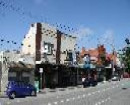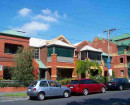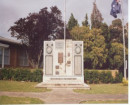MACEDON HOUSE
1 KILMORE ROAD GISBORNE, MACEDON RANGES SHIRE
-
Add to tour
You must log in to do that.
-
Share
-
Shortlist place
You must log in to do that.
- Download report
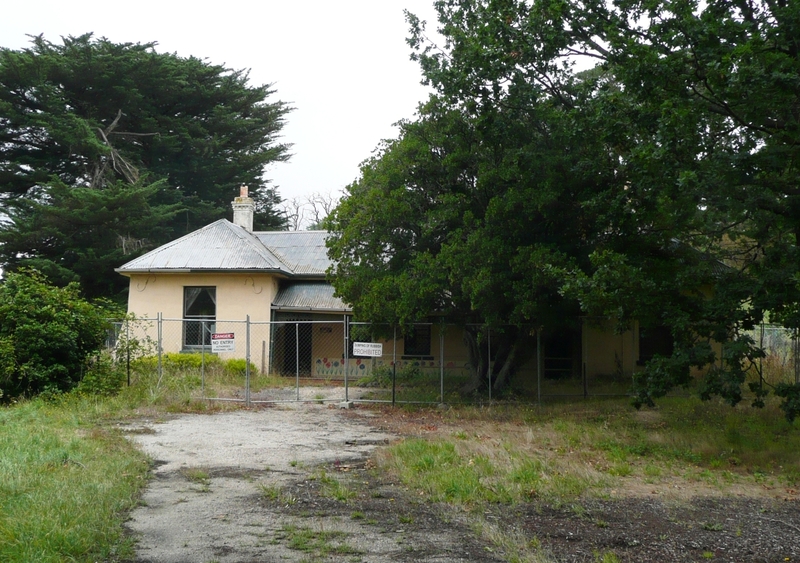

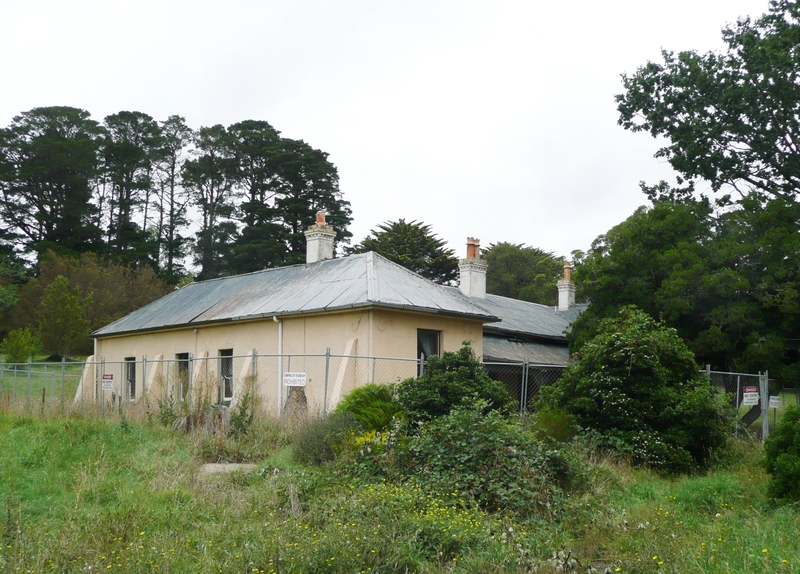




Statement of Significance
What is significant?
Macedon House is believed to have been built for Elizabeth and Thomas Gordon in 1847 as the Mount Macedon Hotel. In September 1847 the Mount Macedon Court of Petty Sessions issued a publican's licence to William McAulay, nominee for Thomas Gordon, for the 'recently erected Mount Macedon Hotel'. The Survey Plan for the township of Gisborne dated 1851 shows an outline of three buildings on the present site. A sketch by Alfred Vickers in 1854 shows the Macedon Hotel flanked by two other buildings.
Thomas and Elizabeth Gordon transferred their licence from the Mount Macedon Hotel to another Gisborne hotel, the Bridge Inn, in 1854. Other licensees of the Mount Macedon Hotel included co-founder of the contracting company Cornish & Bruce, J.V.A. Bruce from 1856 to c.1860; Luke Chambers in 1860; and Alexander Gardiner (who also set up a blacksmith's business) from 1863 until 1867. When the railway line to Bendigo bypassed Gisborne in 1861, trade declined and the hotel was de-licensed in 1867. In 1878 Elizabeth Campbell (who had remarried after the death of Thomas Gordon) returned to live at Macedon House as it was by then known. From 1887 it became a boarding and guest house for many years. During the 20th century it has been used as a private house, restaurant, reception centre, bowling clubhouse and school.
Macedon House is a single storey, rendered, bluestone building with a hardwood-framed roof covered by original shingles beneath a later corrugated iron roof. The roof framing construction is of an unusual dragon beam style. The building is H-shaped in plan with projecting hipped bays. The front bays flank a recessed verandah with corrugated iron roof. The lacework on the timber and iron verandah dates from a later period. At the rear a timber infill section was constructed at an unknown date. Internally most of the original partition walls have been removed. A suspended ceiling was added below the original lathe and plaster finish and the floor has been replaced by a concrete slab. The chimneys, sash widows and timber mouldings survive from various periods.
The curtilage includes the original allotments 1, 2 and 3 and associated street frontage. It includes significant trees which date from the 1890s, including two Monterey Cypress trees, an Irish Strawberry tree and two English Oak trees. The house retains its 19th century landscape setting.
How is it significant?
Macedon House is of historical, architectural and archaeological significance to the State of Victoria.
Why is it significant?
Macedon House is of historical significance as a rare surviving example of an early Victorian hotel. Along with the nearby Keilor Hotel (H1974) it is a significant surviving example of an important stopping place for travellers en route to squatting runs to the north and west of Melbourne, and later to the central Victorian goldfields.
Macedon House is of architectural significance as a representative and relatively intact example of an early hotel and is particularly notable for its external form and plan. The building retains evidence of colonial vernacular construction and original fabric survives.
Macedon House is of archaeological significance for its potential to provide information about the occupation and usage of the inn during the nineteenth century. The site has a high potential to produce artefacts relating to its mid to late nineteenth century occupation. It is likely to contain archaeological remains from outhouses, stables and other site features.
-
-
MACEDON HOUSE - History
History
Mount Macedon Hotel is believed to have been built in 1847 for Thomas and Elizabeth Gordon. The Argus of 17 September 1847 reported that the Mount Macedon Court of Petty Sessions issued a publican’s general licence to William McAulay, nominee for Thomas Gordon, for the “recently erected Mount Macedon Hotel”.
Thomas Gordon was listed as occupying crown land as an inn keeper at Mount Macedon in October 1850 (PRO VPRS 7/P0000/14 Treasury, Inwards Correspondence, 1838-55, Unregistered Letters, 1850-55, Vol 14, p.122).
Elizabeth Gordon was listed as the owner of Allotment 1 Section 1 Area 2 on 16 September 1851 and Thomas Gordon listed as purchaser of Allotments 2 and 3, undated (PRO VPRS 80/P0001 Register of Purchasers of Town Allotments). The earliest title for the land is dated 1 April 1852 in the name of Elizabeth Gordon. The Township plan shows Allotment 1 in the name of E Gordon, 16/9/51, Allotment 2 in the name of T. Gordon 25/1/55 and Allotment 3 T. Gordon 20/2/55.
Watson’s Survey Plan for the township of Gisborne dated 1851 shows the outline of buildings on the present site. The orientation of the main building correlates with the current location of Mount Macedon House.
A pen and ink drawing by Alfred Vickers shows the Mount Macedon Hotel with two outhouses on either side. The sketch is inscribed “Sept 30th 1854 The Mount Macedon Hotel A. H. V”. It is inscribed on verso “Sept 30th 1854 Gisborne Sketched from a sketch from Nature – at Gisborne A. H. Vickers” (State Library of Victoria Picture Collection, H87.35/22). There is also a sketch by Vickers of the Bush Inn with the inscription on verso: “No. 1…The Bush Inn – Gisborne from the Mount Macedon Hotel sketched Sept 24th 1854 from Nature A. H. V.” (SLV, Picture Collection, H87.35/9).
In the 1850s the first Presbyterian minister at Gisborne Rev John Meek conducted church services in the outhouse of the Mount Macedon Hotel. (Old Gisborne “The Bush Inn”: Letters to the Editor of the Gisborne Gazette 1912-1913, Friends of Gisborne Library, Genealogical Centre, 1992. p.12)
According to one source, in 1853 there were 4 hotels in Gisborne, including the Bush Inn and the Mount Macedon Hotel (Old Gisborne “The Bush Inn”: Letters to the Editor of the Gisborne Gazette 1912-1913, Friends of Gisborne Library, Genealogical Centre, 1992. p.3).
Thomas and Elizabeth Gordon transferred their licence from the Mount Macedon Hotel to the Bridge Inn in 1854. (Gisborne & Mount Macedon Historical Society, “History of Macedon House”) Other licensees included J.V.A. Bruce from 1856 to c.1860; Luke Chambers in 1860; and Alexander Gardiner in 1863 until it was delicensed in 1867. Elizabeth Campbell (who had remarried after the death of Thomas Gordon) returned to live at Mount Macedon House, as it was then known, in the 1870s. From 1887 it became a boarding and guest house for many years (G & MHS).
In 1911 Macedon House was used by Miss Gordon, daughter of the owner, as a school. In the 1960s it was a private house occupied by the Sear family. In later years it changed hands a number of times, used as various types of restaurants, and a reception centre (G 7 MHS).
PROV:
VPRS 80/P0001 Register of Purchasers of Town Allotments
Allotment 1 Section 1 Area 2 Elizabeth Gordon 16/9/1851
Allotment 2 Thomas Gordon, n.d.
Allotment 3 Thomas Gordon, n.d.
VPRS 7/P0000/14 Treasury, Inwards Correspondence (Bound), 1838-1855: Unregistered Letters, 1850-1855. Vol. 14, p.122
List of Parties in the Western Port District occupying Crown Lands as Punt-men, Inn-keepers, Shoemakers etc from the 1st July to the 31st December 1850:
Gordon, Thomas, Inn, Mount Macedon
Crown Commissioners Office, Melbourne 22nd October 1850.
MACEDON HOUSE - Permit Exemptions
General Exemptions:General exemptions apply to all places and objects included in the Victorian Heritage Register (VHR). General exemptions have been designed to allow everyday activities, maintenance and changes to your property, which don’t harm its cultural heritage significance, to proceed without the need to obtain approvals under the Heritage Act 2017.Places of worship: In some circumstances, you can alter a place of worship to accommodate religious practices without a permit, but you must notify the Executive Director of Heritage Victoria before you start the works or activities at least 20 business days before the works or activities are to commence.Subdivision/consolidation: Permit exemptions exist for some subdivisions and consolidations. If the subdivision or consolidation is in accordance with a planning permit granted under Part 4 of the Planning and Environment Act 1987 and the application for the planning permit was referred to the Executive Director of Heritage Victoria as a determining referral authority, a permit is not required.Specific exemptions may also apply to your registered place or object. If applicable, these are listed below. Specific exemptions are tailored to the conservation and management needs of an individual registered place or object and set out works and activities that are exempt from the requirements of a permit. Specific exemptions prevail if they conflict with general exemptions. Find out more about heritage permit exemptions here.Specific Exemptions:General Conditions: 1. All exempted alterations are to be planned and carried out in a manner which prevents damage to the fabric of the registered place or object. General Conditions: 2. Should it become apparent during further inspection or the carrying out of works that original or previously hidden or inaccessible details of the place or object are revealed which relate to the significance of the place or object, then the exemption covering such works shall cease and the Executive Director shall be notified as soon as possible. Note: All archaeological places have the potential to contain significant sub-surface artefacts and other remains. In most cases it will be necessary to obtain approval from Heritage Victoria before the undertaking any works that have a significant sub-surface component. General Conditions: 3. If there is a conservation policy and plan approved by the Executive Director, all works shall be in accordance with it. Note: The existence of a Conservation Management Plan or a Heritage Action Plan endorsed by Heritage Victoria provides guidance for the management of the heritage values associated with the site. It may not be necessary to obtain a heritage permit for certain works specified in the management plan. General Conditions: 4. Nothing in this determination prevents the Executive Director from amending or rescinding all or any of the permit exemptions. General Conditions: 5. Nothing in this determination exempts owners or their agents from the responsibility to seek relevant planning or building permits from the responsible authorities where applicable. Minor Works : Note: Any Minor Works that in the opinion of the Executive Director will not adversely affect the heritage significance of the place may be exempt from the permit requirements of the Heritage Act. A person proposing to undertake minor works may submit a proposal to the Executive Director. If the Executive Director is satisfied that the proposed works will not adversely affect the heritage values of the site, the applicant may be exempted from the requirement to obtain a heritage permit. If an applicant is uncertain whether a heritage permit is required, it is recommended that the permits co-ordinator be contacted.
Exterior:
Removal of extraneous items such as air conditioners, pipe work, ducting, wiring, antennae, aerials etc, and making good.
Installation or removal of external fixtures and fittings such as, hot water services and taps.
Interior:
Painting of previously painted walls and ceilings provided that preparation or painting does not remove evidence of any original paint or other decorative scheme.
Installation, removal or replacement of carpets and/or flexible floor coverings.
Installation, removal or replacement of curtain tracks, rods and blinds.
Installation, removal or replacement of hooks, nails and other devices for the hanging of mirrors and paintings.
Refurbishment of existing bathrooms, toilets and kitchens including removal, installation or replacement of sanitary fixtures and associated piping, mirrors, wall and floor coverings.
Removal of tiling or concrete slabs in wet areas provided there is no damage to or alteration of original structure or fabric.
Installation, removal or replacement of electrical wiring.
Installation of new fire hydrant services including sprinklers, fire doors and elements affixed to plaster surfaces.
Landscape:
The process of gardening and maintenance, mowing, hedge clipping, bedding displays, removal of dead plants, disease and weed control, emergency and safety works to care for existing plants and planting themes.
Removal of vegetation that is not significant to maintain fire safety and to conserve significant buildings and structures.
The replanting of plant species to conserve the landscape character and plant collections and themes.
Repairs, conservation and maintenance to hard landscape elements, buildings, structures, ornaments, roads and paths, drainage and irrigation system.
Management of trees in accordance with Australian Standard; Pruning of amenity trees AS4373.
Removal of plants listed as noxious weeds in the Catchment and Land Protection Act 1994.
Installation, removal or replacement of garden watering and drainage systems.
Non-structural works that occur at a distance greater than 5 metres from the canopy edge of a significant tree, plant or hedge, (structural works may require a permit if still on the registered land).
Non-commercial signage, lighting, security fire safety and other safety requirements, provided no structural building occurs.
Resurfacing of existing paths and driveways.
MACEDON HOUSE - Permit Exemption Policy
The purpose of the permit exemptions is to allow works that do not impact on the significance of the place to occur without the need for a permit. Alterations that impact on the significance of the exterior and interior are subject to permit applications.
Any remaining fabric of the 1840s and 1850s will be considered as being of primary significance. Integral to the significance is the original H-plan, walls and roof, including the original shingles, dragon beam roof structure and also the chimneys.
The addition of new buildings or major changes to the landscaping on the registered land will be subject to permit application.
The exemptions policy recognises that some alterations have occurred, mainly to the interior of the building, and that further renewal will be required from time to time.
-
-
-
-
-
GISBORNE SHELTER SHED
 Victorian Heritage Inventory
Victorian Heritage Inventory -
WYABUN PARK REFUSE TIP
 Victorian Heritage Inventory
Victorian Heritage Inventory -
BILLY GOAT FURNACE SITE
 Victorian Heritage Inventory
Victorian Heritage Inventory
-
Archaeological site
 Southern Grampians Shire
Southern Grampians Shire -
Avoca
 Stonnington City H0809
Stonnington City H0809 -
BANYULE
 Victorian Heritage Register H0926
Victorian Heritage Register H0926
-
-



